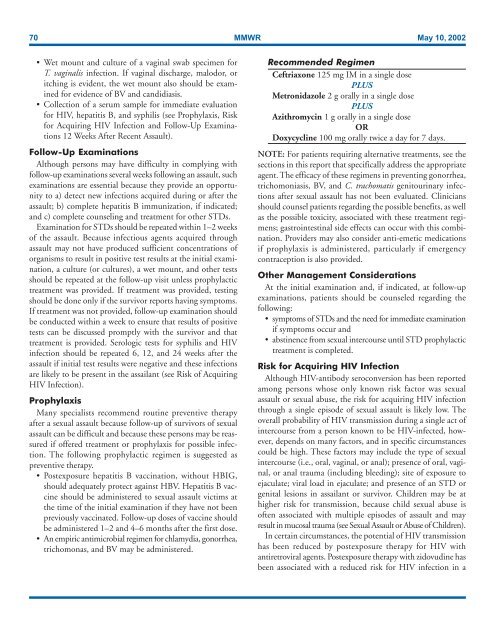You also want an ePaper? Increase the reach of your titles
YUMPU automatically turns print PDFs into web optimized ePapers that Google loves.
70 MMWR May 10, 2002<br />
Wet mount and culture of a vaginal swab specimen for<br />
T. vaginalis infection. If vaginal discharge, malodor, or<br />
itching is evident, the wet mount also should be examined<br />
for evidence of BV and candidiasis.<br />
Collection of a serum sample for immediate evaluation<br />
for HIV, hepatitis B, and syphilis (see Prophylaxis, Risk<br />
for Acquiring HIV Infection and Follow-Up Examinations<br />
12 Weeks After Recent Assault).<br />
Follow-Up Examinations<br />
Although persons may have difficulty in complying with<br />
follow-up examinations several weeks following an assault, such<br />
examinations are essential because they provide an opportunity<br />
to a) detect new infections acquired during or after the<br />
assault; b) complete hepatitis B immunization, if indicated;<br />
and c) complete counseling and treatment for other STDs.<br />
Examination for STDs should be repeated within 1–2 weeks<br />
of the assault. Because infectious agents acquired through<br />
assault may not have produced sufficient concentrations of<br />
organisms to result in positive test results at the initial examination,<br />
a culture (or cultures), a wet mount, and other tests<br />
should be repeated at the follow-up visit u<strong>nl</strong>ess prophylactic<br />
treatment was provided. If treatment was provided, testing<br />
should be done o<strong>nl</strong>y if the survivor reports having symptoms.<br />
If treatment was not provided, follow-up examination should<br />
be conducted within a week to ensure that results of positive<br />
tests can be discussed promptly with the survivor and that<br />
treatment is provided. Serologic tests for syphilis and HIV<br />
infection should be repeated 6, 12, and 24 weeks after the<br />
assault if initial test results were negative and these infections<br />
are likely to be present in the assailant (see Risk of Acquiring<br />
HIV Infection).<br />
Prophylaxis<br />
Many specialists recommend routine preventive therapy<br />
after a sexual assault because follow-up of survivors of sexual<br />
assault can be difficult and because these persons may be reassured<br />
if offered treatment or prophylaxis for possible infection.<br />
The following prophylactic regimen is suggested as<br />
preventive therapy.<br />
Postexposure hepatitis B vaccination, without HBIG,<br />
should adequately protect against HBV. Hepatitis B vaccine<br />
should be administered to sexual assault victims at<br />
the time of the initial examination if they have not been<br />
previously vaccinated. Follow-up doses of vaccine should<br />
be administered 1–2 and 4–6 months after the first dose.<br />
An empiric antimicrobial regimen for chlamydia, gonorrhea,<br />
trichomonas, and BV may be administered.<br />
Recommended Regimen<br />
Ceftriaxone 125 mg IM in a single dose<br />
PLUS<br />
Metronidazole 2 g orally in a single dose<br />
PLUS<br />
Azithromycin 1 g orally in a single dose<br />
OR<br />
Doxycycline 100 mg orally twice a day for 7 days.<br />
NOTE: For patients requiring alternative treatments, see the<br />
sections in this report that specifically address the appropriate<br />
agent. The efficacy of these regimens in preventing gonorrhea,<br />
trichomoniasis, BV, and C. trachomatis genitourinary infections<br />
after sexual assault has not been evaluated. Clinicians<br />
should counsel patients regarding the possible benefits, as well<br />
as the possible toxicity, associated with these treatment regimens;<br />
gastrointestinal side effects can occur with this combination.<br />
Providers may also consider anti-emetic medications<br />
if prophylaxis is administered, particularly if emergency<br />
contraception is also provided.<br />
Other Management Considerations<br />
At the initial examination and, if indicated, at follow-up<br />
examinations, patients should be counseled regarding the<br />
following:<br />
symptoms of STDs and the need for immediate examination<br />
if symptoms occur and<br />
abstinence from sexual intercourse until STD prophylactic<br />
treatment is completed.<br />
Risk for Acquiring HIV Infection<br />
Although HIV-antibody seroconversion has been reported<br />
among persons whose o<strong>nl</strong>y known risk factor was sexual<br />
assault or sexual abuse, the risk for acquiring HIV infection<br />
through a single episode of sexual assault is likely low. The<br />
overall probability of HIV transmission during a single act of<br />
intercourse from a person known to be HIV-infected, however,<br />
depends on many factors, and in specific circumstances<br />
could be high. These factors may include the type of sexual<br />
intercourse (i.e., oral, vaginal, or anal); presence of oral, vaginal,<br />
or anal trauma (including bleeding); site of exposure to<br />
ejaculate; viral load in ejaculate; and presence of an STD or<br />
genital lesions in assailant or survivor. Children may be at<br />
higher risk for transmission, because child sexual abuse is<br />
often associated with multiple episodes of assault and may<br />
result in mucosal trauma (see Sexual Assault or Abuse of Children).<br />
In certain circumstances, the potential of HIV transmission<br />
has been reduced by postexposure therapy for HIV with<br />
antiretroviral agents. Postexposure therapy with zidovudine has<br />
been associated with a reduced risk for HIV infection in a


